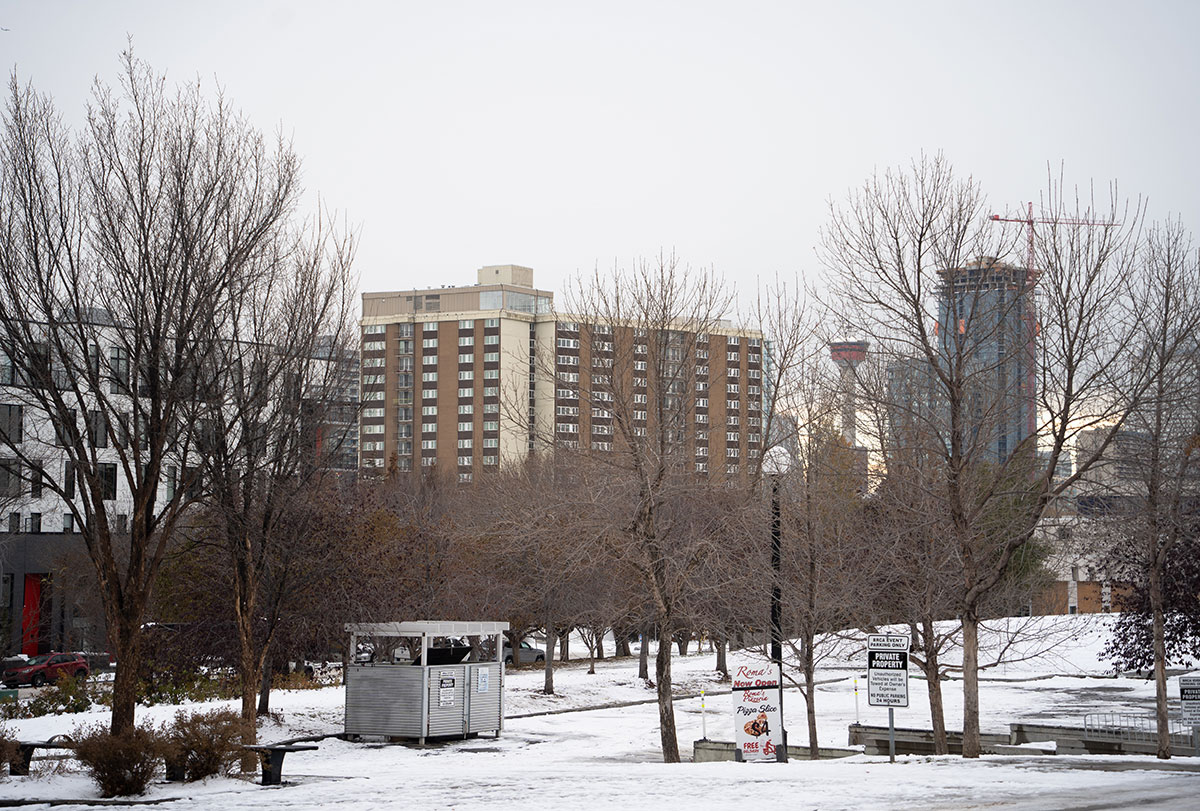With a general election looming, recent budget increases for the housing portfolio seem — at first — like a timely, although small, boon.
The Alberta budget boasts roughly $481 million of capital spending over the next three years on affordable housing, a $200-million increase over last year.
As a growing number of Albertans live in a place that’s unaffordable, crowded or in disrepair, one could believe that the provincial government is finally taking notice of the significance of this issue, even if just to gain electoral favour.
But a 2021 amendment to Alberta’s Affordable Housing Act points at a different goal: publicly funded privatization.
“The amendments lay the groundwork for improving and expanding the affordable housing system to address the demand and improve access for Albertans,” said Josephine Pon, then minister of seniors and housing, at a November 2021 session of the assembly in which the amendment was tabled.
Changes to the act enable the province’s new affordable housing strategy, Stronger Foundations.
Nick Falvo, an independent consultant and researcher, says the primary challenge of the new strategy is insufficient funding. But others see bigger problems.
Laura Murphy, a research co-ordinator at the University of Alberta’s Affordable Housing Solutions Lab, says the strategy opens up the provision of affordable housing to private entities.
“You’ll have real estate investment trusts, real estate operating companies, applying for funding that really just privilege and benefit shareholders and don’t actually reach tenants, who are in desperate need of housing,” she says.
Banning inclusionary zoning, transferring public assets
One of the main outcomes of the new provincial strategy is the Affordable Housing Partnership Program, announced in December alongside $55 million in capital grants for qualifying organizations.
The main objective of the program is to support the creation of 13,000 new affordable housing units for low- and moderate-income Albertans over the next decade. To do this, the provincial government will contribute to the construction of mixed-income and mixed-use developments via capital grants, as well as oversee the transfer of publicly owned assets to qualifying applicants, including non-profits.
The benefits of having a mix of incomes and uses are two-pronged: on the one hand, the mix ensures the financial viability of these assets in the long term; on the other, it unlocks the social benefits of having people of different backgrounds share the same spaces, reducing stigma and concentration of low-income earners.
In December the province removed from the city charters the ability of Calgary and Edmonton to enact inclusionary zoning policies, which would have allowed these cities to mandate the inclusion of below-market units in all new developments, effectively making them mixed-income.
Alberta developers had been lobbying against this provision since Edmonton adopted inclusionary housing as a policy in 2015. In their view, this requirement would discourage the construction of new housing and burden homebuyers.
So is mixed-income housing a feasible alternative only if taxpayers fund it?
Unlike public-private partnerships, where governments retain ownership of a capital asset, the housing created by the Affordable Housing Partnership Program will be owned by private corporations, following the recommendations of the affordable housing review panel in 2020.
To ensure a portion of the units funded remain below market for at least two decades, the program’s guidelines require the placing of an encumbrance in the property titles, as well as yearly reports for the term of the agreement.
“The whole point of non-profit or non-market housing is to exist in perpetuity,” Murphy said. “To be protected from speculation.”
When the partnership program was announced, interested applicants were given five weeks to apply. But the province hasn’t disclosed publicly the specific properties likely to be sold or transferred, saying that doing so “may impact the market in advance.”
Public housing to be sold on the open market
Alberta is not only enabling private ownership of formerly public housing. It will also be encouraging the sale of long-neglected buildings.
Last year, the Ministry of Seniors and Housing reported that 82 per cent of its housing stock was in fair or poor physical condition, a situation highlighted as an impending risk by the affordable housing task force.
To determine the fate of existing housing, the ministry commissioned an asset management framework, which is expected to facilitate the sale of a portion of the existing housing stock.
According to the management framework, about 200 properties that are either in disrepair or located in areas with low demand for affordable housing are to be sold on the open market over the next 10 years. The revenues from the sale of these properties are then to be reinvested in affordable housing, likely through programs like the Affordable Housing Partnership Program.
But selling off these properties could have significant long-term consequences, experts say.
“Once you sell off land, once you sell off housing, where do you go? Where do you buy land?” Murphy said. “That’s the absolute worst thing. You’d be better off doing nothing.”
Despite the accelerated growth of purpose-built rentals in Alberta’s largest cities, a rising number of lower income households are struggling to find suitable housing — over 24,000 low-income families are waiting to access housing they can afford.
Nadine Chalifoux, chair of the Edmonton Coalition on Housing and Homelessness, says that many lower income folks are on the verge of losing their housing altogether, as the city’s rental market continues to tighten and rents skyrocket.
“People are trying to afford housing, there’s no affordable housing for them,” she says. “Market housing is outrageous right now, we don’t have any control over it.”
In Calgary, the housing options available to lower income households are steadily decreasing, according to the Canada Mortgage and Housing Corp.’s most recent rental market report.
The initiatives brought about by the new affordable housing strategy, set to receive nearly $70 million in capital investment over the next three years, coupled with the sector’s level of transparency, could worsen this problem.
According to Falvo’s chapter in an upcoming book, Anger and Angst: Jason Kenney’s Legacy and Alberta’s Right, capital funding for affordable housing in 2022 was already supported by the sale of provincially owned assets. Though it remains unclear which specific assets were disposed of, where they are located, or if any Albertans were impacted by the loss of these units.
The province as regulator, not owner
Alberta’s new strategy also signals a shift in the province’s role in providing affordable housing.
Following the recommendations of the review panel, the strategy envisions the provincial government as a regulator only, superseding its role as an owner and operator of social housing.
With 27,000 units, the Alberta government owns roughly half of the affordable housing stock in the province, and while most of these units are deeply subsidized, they’re also concentrated in buildings constructed in the 1980s.
If these units had been built under the current framework, many of them would be back in the open market, and an even larger number of Albertans would be in housing need — if not houseless.
Changes to the province’s definition of what constitutes affordable housing may only serve to make things worse.
Affordable housing is generally understood to mean housing that constitutes 30 per cent of a household’s income.
But moving forward, “affordable housing” in Alberta will be defined as any housing that’s rented (or owned) at below-market rates — and this is the kind of affordability that the units created by the Affordable Housing Partnership Program will offer.
Divided into three tiers, the affordable housing stock will cater towards Albertans in different income brackets, increasing access to housing with rental rates will ranging between 60 and 90 per cent of median market rate, as calculated by CMHC.
For those households unable to afford 60 per cent of the median market rate, the Affordable Housing Partnership Program plans to deliver direct rental subsidies to about 12,000 additional households over the next decade.
This strategy, Murphy says, “won’t meet the needs of the 60,000 tenant households that are currently paying more than 30 per cent of their income in rent.”
However, this challenge isn’t unique to Alberta. The federal housing strategy has faced criticisms, as some of its programs incentivize private developers to build housing at below-market rates, but fail to address the needs of lower income households.
“For the person who’s actually in need, affordable housing means ‘I can afford it with the income I have,’ and for most people that’s 30 per cent [of their income],” Chalifoux says.
Investment earmarked for the Affordable Housing Partnership Program represents almost 42 per cent of the of the ministry of Seniors, Community and Social Services’ capital plan.
On March 9, the federal government announced $27 million in funding for the Affordable Housing Partnership Program, which will be allocated to 17 affordable housing projects led by the province’s largest non-profits, including Silvera for Seniors and Horizon Housing Society.
“We should put the money in and make actual affordable, rent-geared-to-income housing,” Chalifoux said, as many of the recipients of these grants operate in a mixed-income model.
While proponents argue the mixed-income model encouraged by the Affordable Housing Partnership Program is a financially sustainable scheme that gives lower income households more choice, gearing rental rates to Alberta’s market could contribute to rent inflation, as landlords can continue to fill their units without concern to what local incomes can afford.
According to Murphy, even though subsidies can be life-saving for lower income tenants, they also perpetuate affordability issues.
“We’re feeding into the issue by handing unregulated organizations more public funds,” she says, noting how financialized landlords such as Boardwalk have used government subsidies to prop up returns for shareholders. (Sam Kolias, CEO of Boardwalk, was a member of the affordable housing review panel.)
“I’m not saying that we should cut subsidies tomorrow, they do serve a purpose, but without any sort of regulation we’re actually setting up households for continued failure,” Murphy adds.
To calculate median market rates, CMHC collects data on the rents landlords charge existing tenants — but subsidized units are excluded from this calculation. As a result, the rents reported don’t reflect if market rates are affordable to most tenants. This inflates median market rates and effectively subsidizes the profits of landlords rather than reflecting the needs of lower income Albertans.
As the housing crisis intensifies in Alberta, solving immediate problems is a priority for all levels of government. But urgency shouldn’t undermine foresight.
Instead of tackling the chronic underfunding that led to the housing crisis in the first place, the UCP government’s increased funding, when used in a flawed model, could only serve to make things worse in the future.
“The way to move forward on this is to develop policy that’s really grounded in the fundamental right to housing,” Murphy says. ![]()
Read more: Rights + Justice, Alberta, Housing
















Tyee Commenting Guidelines
Comments that violate guidelines risk being deleted, and violations may result in a temporary or permanent user ban. Maintain the spirit of good conversation to stay in the discussion and be patient with moderators. Comments are reviewed regularly but not in real time.
Do:
Do not: